Click on images to enlarge

habit (Photo: Sheldon Navie)
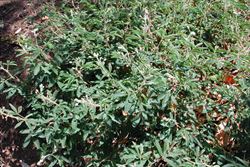
spreading habit (Photo: Sheldon Navie)

creeping habit growing in a lawn (Photo: Sheldon Navie)
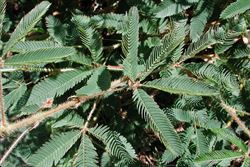
the very hairy stems and leaves of Mimosa pudica var. hispida (Photo: Sheldon Navie)
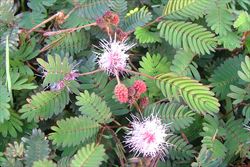
the sparsely hairy stems and leaves of Mimosa pudica var. unijuja (Photo: Sheldon Navie)

close-up of prickly stem with leaf that has closed after being touched (Photo: Sheldon Navie)
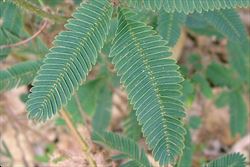
close-up of the elongated leaflets (Photo: Sheldon Navie)
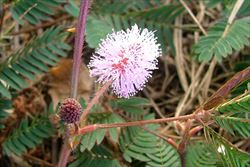
egg-shaped flower clusters borne in the leaf forks (Photo: Sheldon Navie)

close-up of flower cluster and flower buds showing the prominent pink stamens (Photo: Forest and Kim Starr, USGS)
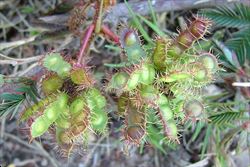
close-up of immature fruit (Photo: Sheldon Navie)

dense clusters of mature fruit (Photo: Sheldon Navie)
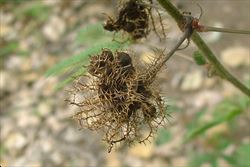
fruit after most of the seeds have been shed (Photo: Sheldon Navie)
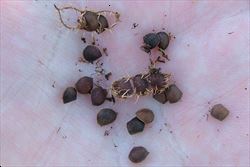
close-up of one-seeded segments that have separated from the fruit (Photo: Sheldon Navie)

close-up of seeds (Photo: Steve Hurst at USDA PLANTS Database)

seedling (Photo: Sheldon Navie)
Scientific Name
Mimosa pudica L.
Family
Fabaceae: sub-family Mimosoideae (New South Wales)Leguminosae (South Australia)Mimosaceae (Queensland, the ACT, Victoria, Tasmania, Western Australia and the Northern Territory)
Common Names
action plant, common sensitive plant, humble plant, live and die, live-and-die, mimosa, sensitive plant, sensitive weed, shame lady, shame plant, shame weed, shamebush, shameplant, touch me not, touch-me-not
Origin
This species originated in tropical Central and South America but is now found throughout the tropical regions of the world (i.e. pan-tropical).
Naturalised Distribution
Widely naturalised in northern and eastern Australia (i.e. in the northern parts of the Northern Territory, in the coastal districts of Queensland and in some inland parts of New South Wales). Also naturalised on Christmas Island.
Habitat
A weed of wetter coastal areas, particularly in tropical and sub-tropical regions. It is mostly found in plantation crops, disturbed sites, pastures, waste areas, parks, lawns, gardens and along roadsides.
Habit
A prickly, long-lived (i.e. perennial), herbaceous plant or small shrub with a creeping (i.e. prostrate or decumbent) or sprawling habit. It usually only grows 15-50 cm tall, but can reach up to 1 m or more in height when supported by other vegetation.
Distinguishing Features
- a low-growing, long-lived, plant with prickly stems and twice-compound leaves that are borne on long stalks.
- its leaves consist of one or two pairs of branchlets, each branchlet having 10-25 pairs of small leaflets (6-15 mm long and 1-3 mm wide).
- the leaves are very sensitive and fold up when touched (hence the name 'sensitive plant').
- its pink or purplish flowers are arranged in small, fluffy, globular or egg-shaped clusters (9-15 mm across).
- its relatively small seed pods (10-25 mm long and 3-6 mm wide) have stiff, almost prickly, bristles along their margins and break apart into one-seeded segments when mature.
Stems and Leaves
The reddish-brown to purplish coloured stems tend to become woody with age. These stems are rounded, much-branched, and armed with small curved prickles (2.5-5 mm long).
The alternately arranged leaves are twice-compound (i.e. bipinnate) and are borne on stalks (i.e. petioles) 15-60 mm long. They consist of one or two pairs of branchlets (i.e. pinnae) that often have a covering of stiff, prickly, bristles. Each of these branchlets (2.5-8 cm long) bears 10-25 pairs of small dark green leaflets. The leaflets are elongated or oblong in shape (6-15 mm long and 1-3 mm wide) with entire margins. Both surfaces of the leaflets are sparsely hairy (i.e. puberulent) and their margins are lined with tiny bristly hairs. The leaves are very sensitive and fold up when touched (they also fold up at night too).
Flowers and Fruit
The pink or purplish coloured flowers are arranged in small, fluffy, globular or egg-shaped (i.e. ovoid) clusters (9-15 mm across). These clusters are borne on bristly stalks (i.e. peduncles) 1-4 cm long in the forks (i.e. axils) of the upper leaves. Individual flowers have four tiny pink petals (about 2 mm long) and four minute sepals. However, the four pink stamens (8-20 mm long) are the most prominent part of the flowers and give them a fluffy appearance. Flowering occurs mostly from summer through to early winter.
The oblong and flattened seed pods (10-25 mm long and 3-6 mm wide) are borne in clusters at the ends of the flowering stalks. These pods each contain 1-6 seeds and their edges are covered in stiff, almost prickly, bristles. They are initially green in colour, but turn brown when mature and eventually break apart into one-seeded segments. The seeds (2.5-3 mm long) are light brown in colour, somewhat flattened, and have a finely textured surface.
Reproduction and Dispersal
This plant reproduces by seeds.
These seeds are dispersed long distances after becoming attached to animals and clothing. They are also commonly spread by water and occasionally as a contaminant of soil and agricultural produce.
Environmental Impact
Common sensitive plant (Mimosa pudica) is a significant environmental weed in Queensland and the Northern Territory, and was recently listed as a priority environmental weed in at least one Natural Resource Management region in Australia.
Legislation
This species is declared under legislation in the following states and territories:
- Northern Territory: B - growth and spread of this species to be controlled (throughout all of the Territory), and C - not to be introduced into the Territory.
- Western Australia: P1 - the movement of this species or its seeds is prohibited (same as below), and P2 - to be eradicated (in the Ashburton, Broome, Carnarvon, Coolgardie, Cue, Derby - West Kimberley, Dundas, East Pilbara, Exmouth, the City of Kalgoorlie-Boulder, Halls Creek, Laverton, Leonora, Meekatharra, Mt Magnet, Murchison, Ngaanyatjarraku, Menzies, Port Hedland, Roebourne, Sandstone, Shark Bay, Upper Gascoyne, Wiluna, Wyndham-East Kimberley and Yalgoo local authority areas).
Management
For information on the management of this species see the following resources:
- the Biosecurity Queensland Fact Sheet on this species, which is available online at http://www.dpi.qld.gov.au.
- the Northern Territory Department of Natural Resources, Environment and The Arts Agnote on this species, which is available online at http://www.nt.gov.au/weeds.
Similar Species
There are three varieties of common sensitive plant (Mimosa pudica) in Australia, which tend to vary in the hairiness of their stems, leaves and flower parts. The densely hairy Mimosa pudica var. hispida and the sparsely hairy Mimosa pudica var. unijuja are both very common, while Mimosa pudica var. tetrandra is relatively rare.
Common sensitive plant (Mimosa pudica) is very similar to giant sensitive tree (Mimosa pigra) and giant sensitive plant (Mimosa diplotricha var. diplotricha), which both also produce pink globular flower clusters and have prickles. It is also relatively similar to the sometimes weedy native sensitive plant (Neptunia gracilis). These species can be distinguished by the following differences:
- common sensitive plant (Mimosa pudica ) is a relatively small plant, with a somewhat spreading (i.e. prostrate) habit, that has few-branched leaves (i.e. with one or two pairs of branchlets). It produces relatively small pods (1- 2.5 cm long) that contain only 1-6 one-seeded segments.
- giant sensitive tree (Mimosa pigra) is a large shrub with an upright (i.e. erect) growth habit that has large much-branched leaves (i.e. with 6-16 pairs of branchlets). It produces relatively large pods (3-8 cm long) that contain 14-26 one-seeded segments.
- giant sensitive plant (Mimosa diplotricha var. diplotricha) is an upright (i.e. erect) shrub or climbing plant that has much-branched leaves (i.e. with 4-9 pairs of branchlets). It produces relatively small pods (1-3.5 cm long) that contain only 3-5 one-seeded segments.
- native sensitive plant (Neptunia gracilis) is a relatively small plant, with a creeping (i.e. prostrate) growth habit, that has few-branched leaves (i.e. with one or two pairs of branchlets). However, it does not have prickles along its stems, has yellow flowers, and its pods do not separate into one-seeded segments when mature.

